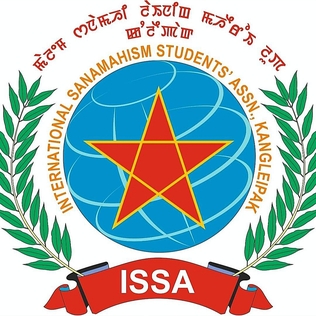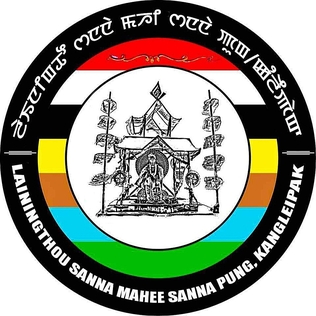
Meitei, officially known as Manipuri, is a Tibeto-Burman language of northeast India. It is the official language and the lingua franca of Manipur as well as one of the 22 official languages of the Indian Republic, included in the 8th Schedule to the Indian Constitution. Native to the Meitei people, it is spoken by around 1.8 million people, predominantly in the state of Manipur, but also by smaller communities in the rest of the country and in parts of neighbouring Myanmar and Bangladesh. It was used as a court language in the historic Manipur Kingdom.

The Meitei people, Meetei people, or Manipuri people is an ethnic group native to Manipur. They form the largest and dominant ethnic group of Manipur in Northeast India. They speak Meitei language, one of the 22 official languages of the Indian Republic and the sole official language of Government of Manipur. The Meiteis primarily settled in the Imphal Valley region in modern-day Manipur, though a sizable population has settled in the other Indian states of Assam, Tripura, Nagaland, Meghalaya, and Mizoram. There is also a notable presence of Meitei people in the neighboring countries of Myanmar and Bangladesh. The Meitei ethnic group represents about 53% of Manipur's population.

The Meitei script, also known as the Meetei script, is an abugida used for the Meitei language, the official language of Manipur state and one of the 22 official languages of India. It is one of the official scripts of the Indian Republic. It is also popularly known as the Kanglei script and the Kok Sam Lai script. Its earliest known evidence of existence dates back to the 6th century AD coins, engraving the Meitei letters, as verified by the various publications of the National Sahitya Akademi. It was used until the 18th century, when it was replaced by the Bengali alphabet. A few manuscripts survive. In the 20th century, the script has experienced a resurgence, and is again being used. Starting from 2021, Meitei script was officially used by the Government of Manipur, along with the Bengali-Assamese script, to write the Meitei language, as per "The Manipur Official Language (Amendment) Act, 2021".

Sanamahism or Meiteism or Lainingthouism, is an ethnic religion of the Meitei people of Kangleipak in Northeast India. It is a polytheistic religion and is named after God Lainingthou Sanamahi, one of the most important deities of the Meitei faith. Sanamahi is the eldest son of the supreme god Yaibirel Sidaba and the supreme goddess Leimarel Sidabi. Traditionally every Meitei household, irrespective of the religion, worships Sanamahi and Leimarel Sidabi. The importance of Sanamahi in the religion is also emphasized in the name itself which means Liquid Gold. Sanamahism does not have a religious head but has a body, Maru Loishang that oversees the main religious activities and govern all affairs pertaining to the religion including conducts of priest and priestess. The Maru Loishang also acts a court for religious disputes. There are three main departments under the Pandit Loishang, namely, the Amaiba Loishang, the Pena Asheiba Loishang and the Amaibi Loishang. These departments have existed since the reign of King Meidingu Hongnemyoi Khunjao Naothingkhong of Manipur in 662 AD.

Imoinu or Emoinu is a goddess associated with household, hearth, family, fireplace, kitchen, wealth, peace and prosperity in Meitei mythology and religion of Ancient Kangleipak. She is frequently associated with Leimarel Sidabi. She is regarded as one of the incarnations or representations of goddess Leimarel Sidabi.

Ningol Chakouba or Chakouba or Hiyangei Nini Paanba is a festival, celebrated by the Meitei people in the second lunar day of Hiyangei (October–November) month of Manipuri calendar. The festival is celebrated in the theme of strengthening of the bond of love between married ladies (ningol) and their paternal families.

Panthoibi Iratpa or Panthoibi Iraat Thouni or Panthoibi Eratpa is a religious festival of the Meitei people dedicated to Panthoibi, the ancient Meitei goddess of civilization, courage, fertility, handicraft, love, victory, warfare and wisdom of Sanamahism. It is celebrated on the first day of the Meitei lunar month of Mera, based on the traditional Meitei calendar. It usually, though not always, coincides with the day of the Hindu festival of Durga Puja, which is based on the Hindu calendar. So, both the festival are often celebrated together in Manipur, despite their religious differences. Goddess Panthoibi is syncretised with Hindu goddess Durga since 1714 AD during the reign of emperor Pamheiba when he made Hinduism as the official religion of the Kingdom of Manipur.

Imoinu Iratpa or Emoinu Iratpa or Waakching Taranithoini Paanba is the religious festival of lights dedicated to the Meitei Goddess Imoinu Ahongbi. The festival is celebrated by the Meitei people following Sanamahism, especially in Manipur. The festival falls on the twelfth lunar day of Wakching month of Meitei calendar.

Meitei Language Day, formally known as Manipuri Language Day, is an International Day observed annually on 20 August. It is a commemoration of the day on which Meitei language was included in the Eighth Schedule to the Constitution of India and made one of the languages with official status in India on 20 August 1992.

The social movement of Meitei language to achieve the officially recognised status of the "Classical language of India" is advocated by various literary, political, social associations and organisations as well as notable individual personalities of Bangladesh, Myanmar, Northeast India.
Miss Kangleipak (Women's Best Physique) is an annual female bodybuilding competition of Kangleipak (Manipur). It co-exists with Miss Manipur, Femina Miss India Manipur and Meetei Chanu. Founded in the year 2012 by the "Manipur Amateur Body Builders Association" (MABBA), Miss Kangleipak is sponsored by the "Janaki Bar Bell Club" (JBC), Singjamei and "Lamyanba Meitei Gym", Sagolband Moirang Hanuba Leirak.

The Emoinu Fish Fest, also known as the Imoinu Fish Festival(Meitei: Imoinu Nga Kummei), is an annual grand fair, organised by the Department of Fisheries, Government of Manipur, on the 12th day of the Meitei lunar month of "Wakching", which is traditionally, the day of Emoinu Eratpa, the sacred festival dedicated to Emoinu (Imoinu), the ancient Meitei goddess of wealth and prosperity. The first edition of the event was organised on 3rd January, 2023. The event was organised in the Hapta Kangjeibung in Imphal East district, Manipur.

The Meitei: Lainingthou Sanamahi Kiyong, lit. 'Lainingthou Sanamahi Shrine'), officially known as the Meitei: Laiyingthou Sanamahi Kiyong, lit. 'Laiyingthou Sanamahi Shrine'), is a temple of God Lainingthou Sanamahi of Meitei religion (Sanamahism), built on the Nongmaiching mountain in the Imphal East district of Kangleipak. It is a center of the Sanamahism followers in Manipur. It is the central body of the "Sanamahi Lainingkol" at Chingoi Maru Langmaiching (Nongmaiching).

The Lainingthou Sanamahi Temple Board (LSTB) is a temple development board of the Lainingthou Sanamahi Temple, Haying Khongban Uphong Yumpham, Imphal West district of Kangleipak (Meitei for 'Manipur'). It is dedicated not only to God Lainingthou Sanamahi and Goddess Leimarel Sidabi of Sanamahism, but also to the other ancient Meitei gods and goddesses of the traditional Meitei religion.

The International Sanamahism Students' Association (ISSA) (Meitei: Malem Sanamahi Laining Maheiroi Lup), also called the International Sanamahism Students' Association, Kangleipak (Meitei: Malem Sanamahi Laining Maheiroi Lup, Kangleipak), is an international non-governmental organization of students of Sanamahism (traditional Meitei religion). It gives its services to the conservation and the upraising of the practices of Sanamahism in the society. It also draws the attention to the government of Manipur state to take up essential steps to protect Sanamahism from getting extinct.

The Lainingthou Sanna Mahee Sanna Pung, Kangleipak, also known as the Lainingthou Sanamahi Sanapung (LSSP), is a non-governmental organization of the followers of the Sanamahism, dedicated to God Lainingthou Sanamahi and other ancient Meitei deities of Kangleipak.

The South East Asia Cultural Organisation (SEACO) is an international cultural organization that works for the development of the Meitei culture of Kangleipak (Meitei for 'Manipur'). It aims to preserve the unique history, culture, identity and religion of Manipur. It also advocates to take "extra caution about the issue of preservation of the cultural identity of the indigenous people in the wake of the present globalization".

The culture of Meitei civilization evolved over thousands of years, beginning in Ancient Manipur, continuing most notably into Medieval Manipur, while influencing the neighboring states and kingdoms.

Meitei festivals are an integral part of the cultural heritage of the Meitei people, an ethnic group native to the Indian state of Manipur. The festivals often celebrate events from Ancient Manipur and often coinciding with seasonal changes. These festivals reflect the unique customs and traditions of the Meitei community, and are celebrated with great enthusiasm and zeal. There are various festivals celebrated throughout the year, each with its own significance and rituals.

Menjor Multipurpose Research Centre and Unity Park, shortly known as MMRC and Unity Park, is a garden, museum, recreation park and research centre for culture of different ethnic and religious groups of Manipur, with a special focus on the Meitei culture. It is located in Khangabok town in Thoubal district of Manipur. It houses a temple of Pakhangba of traditional Meitei religion (Sanamahism), a Hindu temple, a Buddhist temple, a church and a mosque, promoting communal harmony.

















